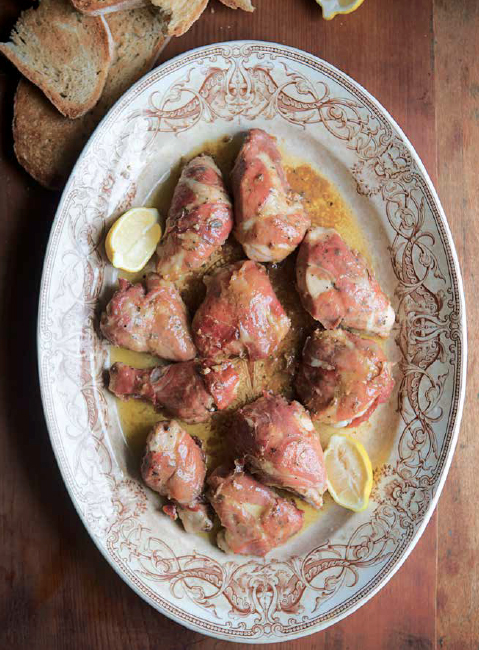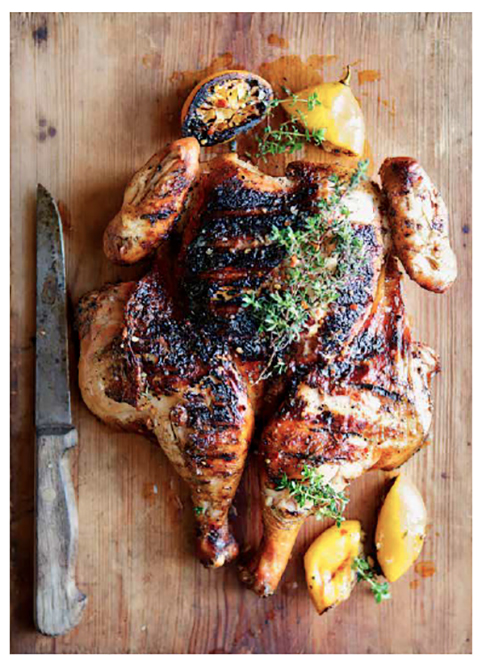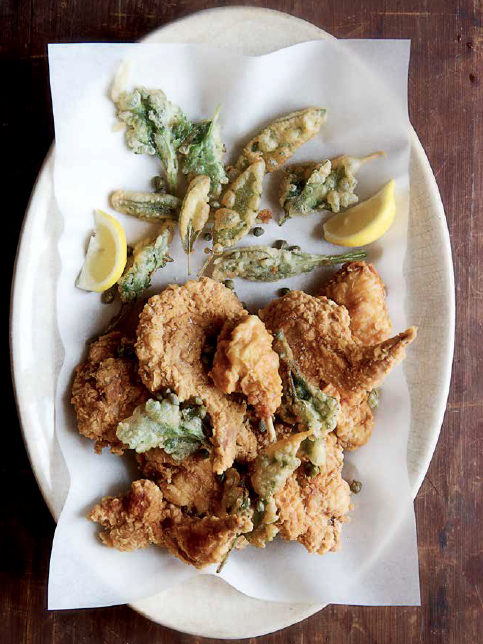
Big Birds & a little rabbit

CHICKEN WRAPPED IN PROSCIUTTO WITH ANCHOVY BUTTER
serves 4–6
If you’ve followed our cooking, you’ll know how crazy we are for anchovy butter. It has everything going for it. Buttery richness, a complex saltiness, and a hit of lemon juice to cut through it all. This chicken dish is bathed in the butter and has plenty extra for sopping up with hunks of lightly toasted bread. Sometimes, instead of using a whole cut-up chicken, we use breasts or thighs. We even serve it as an hors d’oeuvre, wrapping bite-size pieces of chicken breast in prosciutto, then serving them on skewers with a cube of crusty bread on the end.
12 tablespoons (1½ sticks)
salted butter
8 anchovy filets, chopped
2 sprigs fresh sage or 1 sprig fresh rosemary, lightly crushed
1 chicken, 3–4 pounds, cut into
10 pieces
Pepper
10–12 thin slices prosciutto
2 lemons, halved
Preheat the oven to 400°. Put the butter, anchovies, and sage in a small saucepan over medium-low heat. As the butter melts, mash the anchovies with the back of a wooden spoon so they dissolve into the butter. When the butter is melted and bubbling, remove it from the heat. Season the chicken lightly with pepper, then wrap each piece with a slice of prosciutto. Working over a roasting pan to catch any drips, brush the anchovy butter on the chicken, coating it completely, then arrange the pieces in the pan. Roast the chicken, basting it a few times as it cooks, until the juices run clear when pierced, 20–30 minutes. (Check the breast pieces first, they will be done before the thighs and drumsticks.) Transfer the chicken to a serving platter. Stir the remaining anchovy butter into the pan juices that have collected in the bottom of the roasting pan, scraping up any browned bits. Squeeze in the juice of half a lemon. Spoon the pan juices over the chicken. Garnish with the remaining lemons. Serve with thick slices of lightly toasted country bread, if you like.

CHICKEN ALLA DIAVOLA
serves 4–6
Neither one of us particularly likes very spicy hot food. The intensity of the heat can get in the way of the flavor, and we’re usually more interested in flavor rather than sensation. But there are exceptions. This Italian classic—devilishly spicy grilled chicken—is one: It makes our lips burn and tingle, but the heat and flavor are balanced just right. It’s the kind of food we crave when the weather gets hot. We wash it down with cold rosato. Bliss.
1 chicken, 3–4 pounds
2 teaspoons freshly ground
black pepper
1–2 teaspoons crushed red pepper flakes
Salt
¼ cup fresh lemon juice (1–2 lemons)
½ cup extra-virgin olive oil
Using a pair of kitchen shears, cut out the backbone of the chicken (save it for making stock, if you like). Rinse the bird and pat it dry with paper towels. Spread the chicken out skin side up so it lays flat. Tuck the wing tips neatly behind the wings or snip them off. Season the chicken all over with the black pepper, red pepper flakes, and salt, rubbing the seasonings into the skin until it is well coated. Put the chicken skin side up in a large dish. Combine the lemon juice and olive oil in a small bowl and pour it over the bird. Let the chicken marinate at room temperature for 1 hour, turning it over halfway through.
Prepare a medium-hot fire to one side of a charcoal grill. If using a gas grill, fire up the “back burner” to medium-hot heat. Grill the chicken skin side down in the center of the grill until well marked and slightly charred in places, about 20 minutes. Baste the chicken often with the leftover marinade, taking care not to drip too much oil onto the coals to avoid flare-ups. Move the chicken to a cooler spot on the grill if there are flare-ups and the chicken begins to burn. Turn the chicken and grill the other side until the thigh juices run clear when pierced, about 20 minutes.
Transfer the chicken to a cutting board and let it rest for about 10 minutes before cutting it up and serving.
GRILLED CHICKEN INVOLTINI
serves 4–6
These involtini (stuffed rolls) take a little time to fill and roll up (that’s the fun part of making these to us), but once they’re skewered, they cook very quickly.
½ cup pitted green olives in brine, drained and finely chopped
6 anchovy filets, finely chopped
1 large handful parsley leaves, finely chopped
3 tablespoons extra-virgin olive oil, plus more for drizzling
1½ pounds chicken cutlets, about 12
Salt and pepper
4–6 lemon wedges
Stir together the olives, anchovies, parsley, and olive oil in a small bowl. This makes ¾ cup of filling. Set aside. Soak 8–12 wooden skewers in a pan of water to keep them from singeing on the grill.
Use the smooth side of a meat pounder on a sturdy work surface and lightly pound each chicken cutlet into a roughly 4 × 6-inch rectangle. Lightly season the cutlets with salt and pepper. Spread about 1 tablespoon of the olive filling evenly over the meat. Working with one cutlet at a time and starting with a narrow side, roll up the cutlet like a jelly roll. Repeat with the remaining cutlets and filling until there are 12 involtini.
Thread up to 3 chicken involtini onto 2 parallel wooden skewers. Set them about 1 inch apart, leaving an inch or two between each involtini. (Doubling up on the skewers prevents the involtini from swiveling on the skewers. See the photograph of Grilled Veal Birds.) Drizzle the involtini with olive oil and season with salt and pepper.
Prepare a medium-hot charcoal or gas grill. Grill the chicken skewers until well marked and lightly browned on both sides, 1–1½ minutes per side. Transfer the chicken skewers to a serving platter as done. Drizzle with olive oil and season with a little salt. Serve warm with lemon wedges.
VARIATION: We also like to fill the chicken involtini with this mash: 6 minced anchovy filets, 1–2 minced cloves garlic, 1 bunch chopped fresh parsley, ¼ cup grated parmigiano-reggiano, and ¼ cup extra-virgin olive oil.
PORCHETTA-STYLE CHICKEN
serves 4
The traditional herbs used in porchetta, the deservedly famous pork roast from the Lazio region of Italy, are wild fennel, rosemary, and garlic—big, bold flavors that we think also go well with chicken. Spatchcocking the bird (cutting out the backbone and opening up the chicken so it lays flat) allows more room for stuffing seasonings under the skin, helps the chicken cook more evenly, and makes carving the bird a breeze.
1–2 teaspoons fennel seeds,
lightly toasted
1 clove garlic, chopped
1 large sprig fresh rosemary, leaves chopped
1 large sprig fresh sage, leaves chopped
Salt and pepper
Finely grated zest of 2 lemons
1 chicken, 3–4 pounds
1 tablespoon extra-virgin olive oil
Crush the toasted fennel seeds with a mortar and pestle. Add the garlic, rosemary, sage, and a generous pinch of salt and pepper, and crush to a paste. Stir in the lemon zest and set the paste aside.
Using a pair of kitchen shears, cut out the backbone of the chicken (save it for making stock, if you like). Rinse the bird and pat it dry with paper towels. Spread the chicken out skin side up so it lays flat. Tuck the wing tips neatly behind the wings or snip them off. Use your fingers to loosen the skin from the breast and thighs, taking care not to tear the skin. Rub the herb paste under the skin all over the flesh. Season the bird all over with salt and set aside at room temperature for 1–2 hours. Or, cover with plastic wrap and refrigerate overnight.
Preheat the oven to 450°. Set the chicken skin side up on a wire rack set in a roasting pan and rub all over with olive oil. Add 1 cup water to the pan. Roast the chicken until golden brown and the thigh juices run clear when pierced, 40–45 minutes. Remove the chicken from the oven and let it rest for about 10 minutes before cutting up and serving.

FRIED RABBIT & FRITTO MISTO OF HERBS
serves 4
We are lucky enough to have a young couple nearby who raise livestock, including rabbit, in the old-fashioned humane way. Yes, it’s the delicate white meat many Americans are squeamish about, but it sure is tasty. In summer, we serve it fried—hot or cold, as you would fried chicken—alongside a fritto misto of the herbs rabbits like to eat, as a way of honoring the animal.
FOR THE FRITTO MISTO
½ cup all-purpose flour
¼ teaspoon salt
½–1 cup white wine
Canola oil
2 handfuls each fresh sage leaves and parsley sprigs
FOR THE RABBIT
2 cups all-purpose flour
3 eggs
Olive oil
1 cleaned rabbit, cut into 12 pieces
Salt and pepper
Capers, drained
1–2 lemons, quartered
For the fritto misto, whisk the flour and salt together in a medium bowl. Add the wine, whisking until the batter is smooth. Let it rest for 30 minutes. For the rabbit, put the flour in a dish, beat the eggs in another dish, and set aside. Add enough oil to a large heavy skillet to reach a depth of ½ inch. Heat over medium heat until hot or until it reaches 350° on a candy thermometer.
Meanwhile, season the rabbit with salt and pepper and dredge each piece in flour, dip in egg, then dredge in flour, shaking off excess. Working in batches, fry the rabbit until golden brown all over, about 10 minutes. Transfer the rabbit to a wire rack set over paper towels to drain. Season with salt.
To fry the herbs, add enough canola oil to a heavy, deep pot to reach a depth of 2 inches. Heat the oil over medium heat until hot or until it reaches 350° on a candy thermometer. Give the batter a quick whisk.
Dip 1 sage leaf or parsley sprig at a time in the batter and carefully lower it into the hot oil. Fry herbs in small batches until golden and crisp, about 1 minute. Drain on the wire rack. Season with salt. Serve the rabbit and herbs scattered with capers and garnished with lemon.